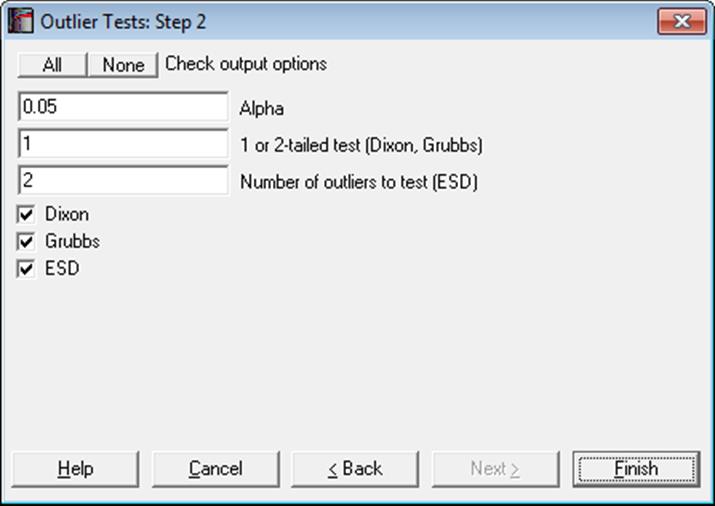6.3.4. Outlier Tests

The three outlier tests supported here will detect whether a minimum or a maximum value is an outlier and test its significance by comparing the test statistic with a critical value. The critical table values are generated by the program for any alpha level, not just for 1%, 5%, 10%. For Dixon and Grubbs tests, if the one-tail option is selected, a separate one-tailed test is performed for the minimum and maximum values of data. If a two-tailed test is selected the larger of the minimum and maximum test values is tested against a two-tailed table value. ESD test is two-tailed only.
If significant outlier(s) are found, their values are displayed in a separate table.
6.3.4.1. Dixon
Dixon’s test does not assume normal distribution of data and is useful in detecting outliers in small sized groups.
The data is sorted in ascending order and two separate Q values are obtained for the lowest and highest values in data. Separate tests are performed for minimum and maximum values according to formulas given by Dixon (1953).
|
|
Minimum |
Maximum |
|
3 ≤ n ≤ 7 |
|
|
|
8 ≤ n ≤ 10 |
|
|
|
11 ≤ n ≤ 13 |
|
|
|
14 ≤ n ≤ 1000 |
|
|
If a two-tailed test is selected, the larger of the QMin and QMax is tested against the table value computed for alpha / 2. Note that the one-tail table Q is very accurate but the two-tailed Q is an approximation.
Example
Sachs, L. (1984), p. 278 gives the following four observations 157, 326, 177, 176 and finds that 326 is an outlier at 5% level (one-tailed test).
Dixon’s Outlier Test
Alpha = 0.05
One-tailed tests
|
|
Dixon’s Q |
Table Q |
Pass/Fail |
|
C1 Q(Min) |
0.1124 |
0.7655 |
Pass |
|
Q(Max) |
0.8817 |
0.7655 |
**Fail** |
N = 4, Q(Min)=(X(2)-X(1))/(X(N)-X(1)), Q(Max)=(X(N)-X(N-1))/(X(N)-X(1))
|
|
Outlier Value |
|
C1 |
326 |
On the other hand, although in the sequence 1, 2, 3, 4, 5, 9 the value 9 looks like an outlier, it is not significantly different from the rest of the numbers at 5% level.
Dixon’s Outlier Test
Alpha = 0.05
One-tailed tests
|
|
Dixon’s Q |
Table Q |
Pass/Fail |
|
C1 Q(Min) |
0.1250 |
0.5624 |
Pass |
|
Q(Max) |
0.5000 |
0.5624 |
Pass |
N = 6, Q(Min)=(X(2)-X(1))/(X(N)-X(1)), Q(Max)=(X(N)-X(N-1))/(X(N)-X(1))
6.3.4.2. Grubbs
Grubbs test requires that the data is approximately normally distributed and thus it is accurate for larger values of n. For one-tailed tests the test statistic G is calculated for minimum and maximum observations separately as follows:
![]()
![]()
For a two-tailed test greater of the GMin and GMax values is tested against the two-tailed table value for the given alpha. Table G is accurate for both one and two-tail tests.
Example
Tietjen and Moore (1972) test the following sequence of numbers 199.31, 199.53, 200.19, 200.82, 201.92, 201.95, 202.18, 245.57 for outliers.
Grubbs’ Outlier Test
Alpha = 0.05
One-tailed tests
|
|
Grubbs’ G |
Table G |
Pass/Fail |
|
C1 G(Min) |
0.4494 |
2.0317 |
Pass |
|
G(Max) |
2.4688 |
2.0317 |
**Fail** |
G = Maximum deviation from mean / Standard Deviation
|
|
Outlier Value |
|
C1 |
245.57 |
6.3.4.3. ESD (Generalised Extreme Studentised Deviate)
While Dixon’s and Grubbs’ tests can detect one outlier at a time, the Generalized Extreme Studentised Deviate (ESD) test can be used to test several outliers simultaneously. It is basically a Grubbs’ test run several times on the same sample, each time testing and omitting the most extreme observation and reducing the degrees of freedom by one. The user specifies the maximum number of extreme values to be tested.
The ESD test is two-tailed.
Example
In this example Rosner (1983) searches for 10 outliers in a series of 54 numbers. Open GOODFIT, select Statistics 1 → Goodness of Fit Tests → Outlier Tests and select VitE (C8) as [Variable]. On the Output Options Dialogue enter 10 into the Number of outliers to test (ESD) box, check only the ESD test and click [Finish] to obtain the following results:
ESD Outlier Test
Alpha = 0.05
Two-tailed test
Number of outliers to check (ESD) = 10
|
|
ESD Ri |
Table Ri |
Pass/Fail |
|
C1 (Max) 1 |
3.1189 |
3.1588 |
Pass |
|
C1 (Max) 2 |
2.9430 |
3.1514 |
Pass |
|
C1 (Max) 3 |
3.1794 |
3.1439 |
**Fail** |
|
C1 (Max) 4 |
2.8102 |
3.1362 |
Pass |
|
C1 (Min) 5 |
2.8156 |
3.1282 |
Pass |
|
C1 (Max) 6 |
2.8482 |
3.1201 |
Pass |
|
C1 (Max) 7 |
2.2793 |
3.1118 |
Pass |
|
C1 (Max) 8 |
2.3104 |
3.1032 |
Pass |
|
C1 (Min) 9 |
2.1016 |
3.0945 |
Pass |
|
C1 (Max) 10 |
2.0672 |
3.0854 |
Pass |
Ri = Generalised Extreme Studentised Deviate
|
|
Outlier Value |
|
C1 |
5.34 |
